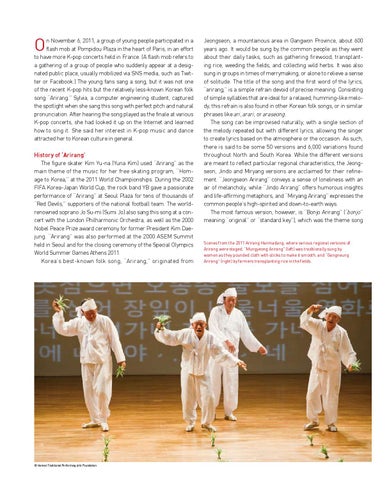O
n November 6, 2011, a group of young people participated in a flash mob at Pompidou Plaza in the heart of Paris, in an effort to have more K-pop concerts held in France. (A flash mob refers to a gathering of a group of people who suddenly appear at a designated public place, usually mobilized via SNS media, such as Twitter or Facebook.) The young fans sang a song, but it was not one of the recent K-pop hits but the relatively less-known Korean folk song “Arirang.” Sylvia, a computer engineering student, captured the spotlight when she sang this song with perfect pitch and natural pronunciation. After hearing the song played as the finale at various K-pop concerts, she had looked it up on the Internet and learned how to sing it. She said her interest in K-pop music and dance attracted her to Korean culture in general.
History of ‘Arirang’ The figure skater Kim Yu-na (Yuna Kim) used “Arirang” as the main theme of the music for her free skating program, “Homage to Korea,” at the 2011 World Championships. During the 2002 FIFA Korea-Japan World Cup, the rock band YB gave a passionate performance of “Arirang” at Seoul Plaza for tens of thousands of “Red Devils,” supporters of the national football team. The worldrenowned soprano Jo Su-mi (Sumi Jo) also sang this song at a concert with the London Philharmonic Orchestra, as well as the 2000 Nobel Peace Prize award ceremony for former President Kim Daejung. “Arirang” was also performed at the 2000 ASEM Summit held in Seoul and for the closing ceremony of the Special Olympics World Summer Games Athens 2011. Korea’s best-known folk song, “Arirang,” originated from
Koreana ı Spring 2012 © Korean Traditional Performing Arts Foundation
Jeongseon, a mountainous area in Gangwon Province, about 600 years ago. It would be sung by the common people as they went about their daily tasks, such as gathering firewood, transplanting rice, weeding the fields, and collecting wild herbs. It was also sung in groups in times of merrymaking, or alone to relieve a sense of solitude. The title of the song and the first word of the lyrics, “arirang,” is a simple refrain devoid of precise meaning. Consisting of simple syllables that are ideal for a relaxed, humming-like melody, this refrain is also found in other Korean folk songs, or in similar phrases like ari , arari , or araseong . The song can be improvised naturally, with a single section of the melody repeated but with different lyrics, allowing the singer to create lyrics based on the atmosphere or the occasion. As such, there is said to be some 50 versions and 6,000 variations found throughout North and South Korea. While the different versions are meant to reflect particular regional characteristics, the Jeongseon, Jindo and Miryang versions are acclaimed for their refinement. “Jeongseon Arirang” conveys a sense of loneliness with an air of melancholy, while “Jindo Arirang” offers humorous insights and life-affirming metaphors, and “Miryang Arirang” expresses the common people’s high-spirited and down-to-earth ways. The most famous version, however, is “Bonjo Arirang” (“bonjo ” meaning “original” or “standard key”), which was the theme song
Scenes from the 2011 Arirang Hanmadang, where various regional versions of Arirang were staged; “Mungyeong Arirang” (left) was traditionally sung by women as they pounded cloth with sticks to make it smooth, and “Gangneung Arirang” (right) by farmers transplanting rice in the fields.
31
